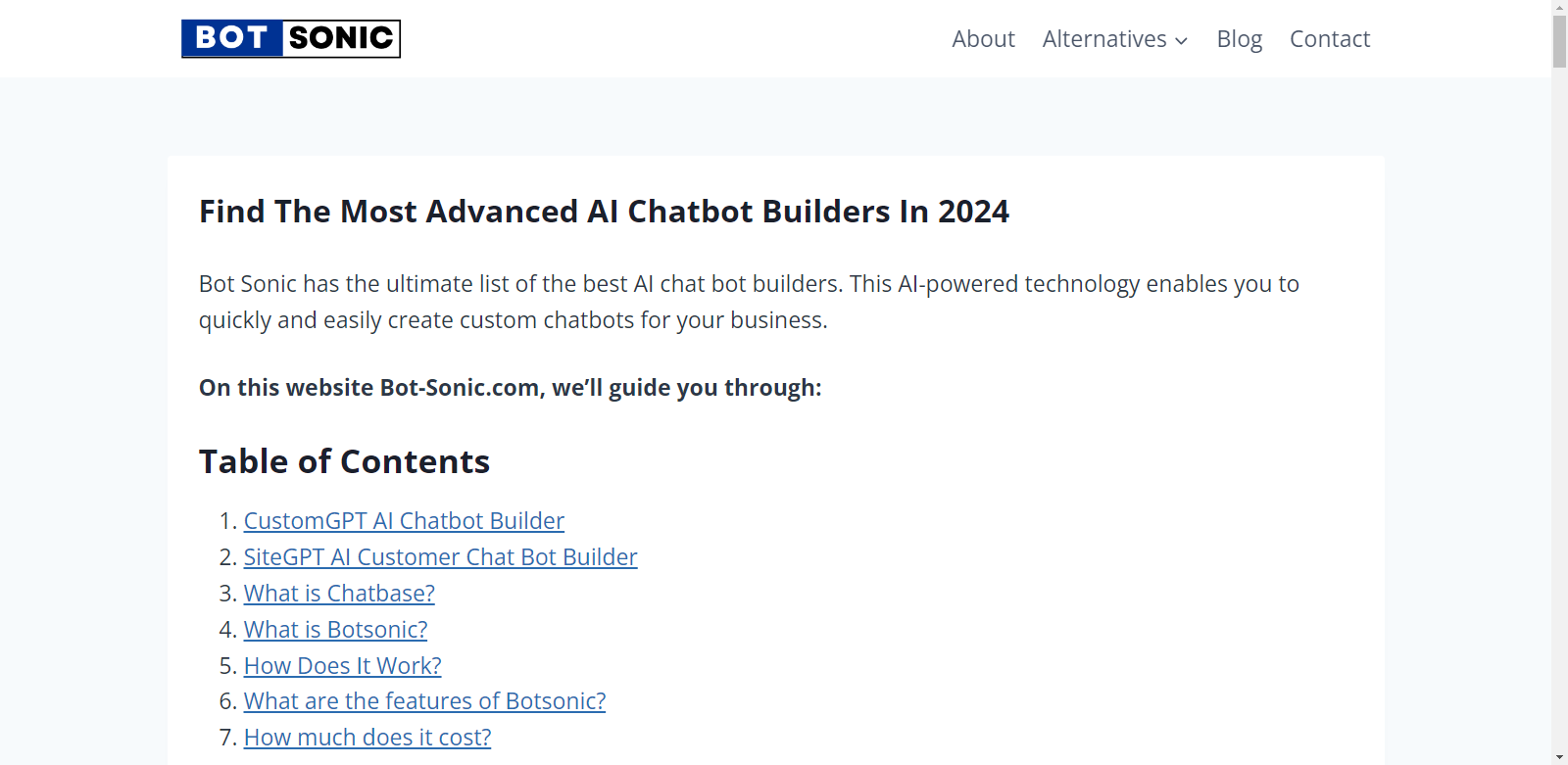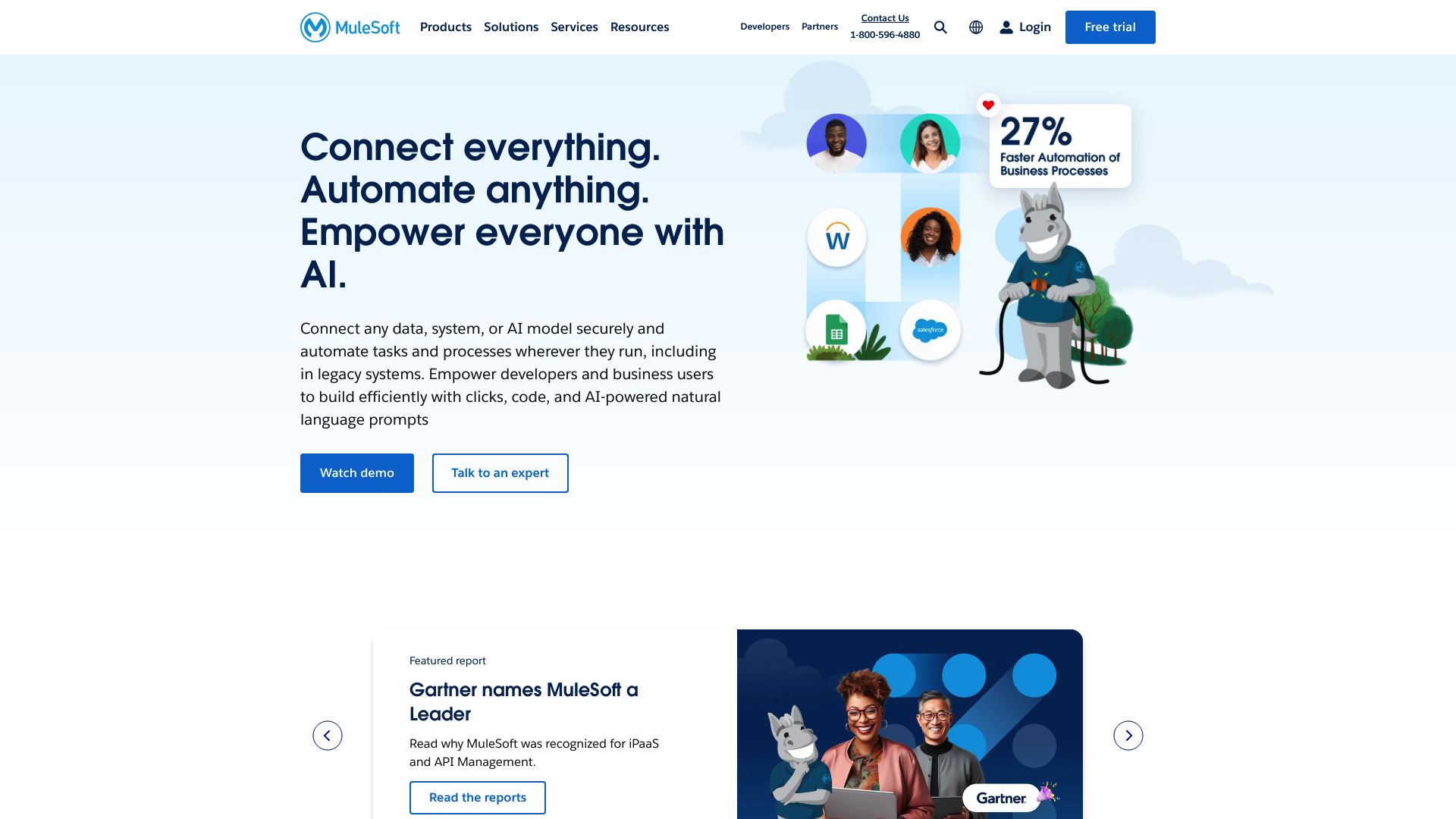Botsonic/Writesonic vs. Mulesoft: AI Chatbots or API Integration?
AI and integration solutions reshape business operations, driving efficiency and innovation. Botsonic/Writesonic vs. Mulesoft offer unique approaches to these challenges, each with distinct strengths and limitations. Botsonic excels in no-code AI chatbot creation, while Mulesoft provides powerful API management and integration tools.
This comparison explores their key features, use cases, and potential drawbacks. We’ll also introduce SmythOS, a comprehensive platform that combines the best of both worlds, offering advanced AI agent creation, robust integration capabilities, and unique features that address the limitations of its competitors.
Whether you’re a developer seeking powerful API tools, a business leader looking to streamline operations, or a non-technical professional aiming to harness AI, this guide will help you navigate the landscape of AI and integration solutions.
Botsonic/Writesonic Overview
Botsonic/Writesonic empowers businesses to create intelligent AI chatbots without coding expertise. This no-code platform leverages GPT-4 technology to deliver human-like conversations across multiple languages. Botsonic’s visual builder enables rapid chatbot development and customization, allowing companies to enhance customer support and engagement efficiently.
Botsonic/Writesonic empowers businesses to create intelligent AI chatbots without coding expertise. This no-code platform leverages GPT-4 technology to deliver human-like conversations across multiple languages.


Botsonic excels in integrating with popular business tools like Salesforce and Google Docs. Users can train chatbots on various data sources, including websites, PDFs, and Word documents. This versatility makes Botsonic suitable for diverse industries seeking to automate customer interactions and streamline support processes.
While Botsonic offers impressive features, it lacks some advanced capabilities. The platform does not support multimodal inputs or provide a dedicated debug mode for developers. Additionally, there’s no explicit support for multi-agent collaboration or constrained alignment to ensure strict adherence to predefined guidelines.
Botsonic’s strength lies in its user-friendly interface and quick deployment options. The platform allows for seamless embedding on websites and integration via APIs and webhooks. However, users seeking more complex AI agent interactions or extensive customization options may find Botsonic’s capabilities limiting compared to more advanced platforms in the market.
Mulesoft Overview
Mulesoft stands at the forefront of integration and API management solutions. Their Anypoint Platform empowers organizations to connect data, applications, and devices across on-premises and cloud environments. This unified platform streamlines the creation, management, and deployment of APIs, fostering seamless connectivity and digital transformation.


Mulesoft’s API-led connectivity approach enables businesses to build reusable assets, accelerating development cycles and enhancing operational efficiency. The platform’s integration with Einstein AI introduces advanced capabilities, allowing developers to generate MuleSoft flows and perform intelligent data mapping using natural language prompts. This AI-powered functionality significantly boosts productivity and reduces the complexity of integration projects.
Mulesoft’s API-led connectivity approach enables businesses to build reusable assets, accelerating development cycles and enhancing operational efficiency.
Security and governance remain paramount in Mulesoft’s offerings. The Anypoint Flex Gateway provides robust API management and security features, ensuring controlled access and protection of sensitive data. Additionally, Mulesoft’s integration products excel at connecting disparate data silos, enhancing AI outputs to drive personalized interactions across various business functions.
While Mulesoft offers powerful tools for integration and API management, users may face a learning curve when mastering the platform’s extensive capabilities. The complexity of some features might require specialized knowledge, potentially presenting challenges for organizations with limited technical resources. However, Mulesoft’s comprehensive documentation and community support help mitigate these concerns, providing resources for users to overcome initial hurdles and maximize the platform’s potential.
Feature Comparison
Botsonic/Writesonic and Mulesoft offer distinct approaches to AI and integration solutions. Botsonic excels in creating AI chatbots without coding, leveraging GPT-4 for human-like conversations across languages. Its visual builder enables rapid chatbot development and customization, ideal for enhancing customer support. Mulesoft, conversely, focuses on API management and integration, providing tools to connect data, applications, and devices across various environments.
A key feature gap lies in their core components. While Botsonic specializes in AI-driven chatbots, Mulesoft’s Anypoint Platform offers comprehensive API lifecycle management. Mulesoft’s integration with Einstein AI introduces advanced capabilities for generating MuleSoft flows and intelligent data mapping, a feature Botsonic lacks. In terms of security, Mulesoft’s Anypoint Flex Gateway provides robust API management and security features, offering more extensive protection than Botsonic’s basic encryption and OAuth support.
We offer a unified platform that combines the strengths of both systems. Our solution provides AI agent creation capabilities similar to Botsonic, while also offering robust API management and integration tools comparable to Mulesoft. We enhance this with advanced features like multi-agent collaboration, constrained alignment, and a debug mode, addressing limitations in both Botsonic and Mulesoft’s offerings. Our platform’s versatility and comprehensive feature set position it as a superior choice for organizations seeking a complete AI and integration solution.
Feature Comparison Table
| Botsonic/Writesonic | Mulesoft | SmythOS | |
|---|---|---|---|
| CORE FEATURES | |||
| Visual Builder | ❌ | ✅ | ✅ |
| Memory & Context | ✅ | ❌ | ✅ |
| Explainability & Transparency | ✅ | ❌ | ✅ |
| Debug Tools | ❌ | ✅ | ✅ |
| Multimodal | ❌ | ✅ | ✅ |
| Problem-Solving Capabilities | ✅ | ❌ | ✅ |
| Multi-Agent Collaboration | ❌ | ✅ | ✅ |
| Human-AI Interaction | ✅ | ❌ | ✅ |
| Audit Logs for Analytics | ✅ | ❌ | ✅ |
| Work as Team | ❌ | ✅ | ✅ |
| Bulk Work | ❌ | ✅ | ✅ |
| Agent Work Scheduler | ❌ | ✅ | ✅ |
| SECURITY | |||
| Constrained Alignment | ❌ | ✅ | ✅ |
| Data Encryption | ❌ | ❌ | ✅ |
| OAuth | ❌ | ✅ | ✅ |
| COMPONENTS | |||
| Huggingface AIs | ❌ | ❌ | ✅ |
| Zapier APIs | ❌ | ❌ | ✅ |
| All other APIs, RPA | ✅ | ❌ | ✅ |
| Classifiers | ❌ | ✅ | ✅ |
| Logic | ✅ | ❌ | ✅ |
| Data Lakes | ❌ | ✅ | ✅ |
| DEPLOYMENT OPTIONS (EMBODIMENTS) | |||
| Deploy as Webhook | ❌ | ✅ | ✅ |
| Staging Domains | ❌ | ✅ | ✅ |
| API Authentication (OAuth + Key) | ❌ | ✅ | ✅ |
| Deploy as Scheduled Agent | ❌ | ❌ | ✅ |
| Scalability | ✅ | ❌ | ✅ |
| DATA LAKE SUPPORT | |||
| Hosted Vector Database | ❌ | ✅ | ✅ |
| Sitemap Crawler | ✅ | ❌ | ✅ |
| YouTube Transcript Crawler | ✅ | ❌ | ✅ |
| URL Crawler | ✅ | ❌ | ✅ |
| PDF Support | ✅ | ❌ | ✅ |
Best Alternative to Botsonic/Writesonic and Mulesoft
SmythOS emerges as the superior alternative to Botsonic/Writesonic and Mulesoft, offering a comprehensive platform for AI agent creation and management. Our solution combines the strengths of both competitors while addressing their limitations, providing users with a powerful, versatile, and user-friendly experience.
Unlike Botsonic’s focus on chatbots or Mulesoft’s emphasis on API management, SmythOS delivers a complete ecosystem for AI development. Our visual builder surpasses Botsonic’s capabilities, allowing users to create complex AI workflows without extensive coding knowledge. This feature democratizes AI development, making it accessible to a broader audience while still providing the depth technical users require.
SmythOS delivers a complete ecosystem for AI development… allowing users to create complex AI workflows without extensive coding knowledge.
SmythOS excels in multi-agent collaboration, a critical feature absent in Botsonic. Our platform enables teams of AI agents to work together on complex tasks, enhancing efficiency and scalability. This capability, combined with our robust API integration tools, positions SmythOS as a more comprehensive solution than Mulesoft for organizations seeking to leverage AI across various business processes.
Security and scalability set SmythOS apart from both competitors. We offer advanced features like constrained alignment and data encryption, ensuring AI agents operate within defined parameters and maintain data integrity. Our platform’s scalability surpasses Mulesoft’s offerings, allowing seamless growth from small-scale prototypes to enterprise-level deployments.
By choosing SmythOS, users gain access to a unified platform that not only matches but exceeds the capabilities of Botsonic/Writesonic and Mulesoft. Our solution empowers organizations to create, deploy, and manage AI agents efficiently, driving innovation and productivity across industries.
Conclusion
Botsonic/Writesonic and Mulesoft offer unique solutions in the AI and integration landscape. Botsonic excels in no-code AI chatbot creation, leveraging GPT-4 for multilingual, human-like conversations. Its visual builder and rapid deployment options make it attractive for businesses seeking quick customer engagement solutions. Mulesoft, on the other hand, stands out with its comprehensive API management and integration capabilities, particularly beneficial for enterprises navigating complex digital transformations.
While both platforms have their strengths, they also have limitations. Botsonic lacks advanced features like multimodal inputs and multi-agent collaboration, potentially restricting its use in more complex scenarios. Mulesoft, despite its powerful integration tools, presents a steeper learning curve that may challenge organizations with limited technical resources.
SmythOS emerges as a superior alternative, combining the strengths of both platforms while addressing their limitations. We offer an intuitive drag-and-drop interface for creating AI agents, similar to Botsonic’s ease of use, while also providing robust API management and integration capabilities akin to Mulesoft. Our platform goes further by supporting multi-agent collaboration, constrained alignment, and a debug mode, features absent in both Botsonic and Mulesoft. This comprehensive approach makes SmythOS ideal for a wide range of users, from non-technical professionals to experienced developers.
For those looking to harness the full potential of AI and integration in their business processes, we invite you to explore our diverse range of AI-powered agent templates. These templates cover multiple business categories and are designed to streamline processes across various functions. To experience the power of SmythOS firsthand, create a free account and start building AI agents with no time limit. With our platform, you can automate complex workflows, deploy AI agents across multiple channels, and transform your business operations with unparalleled efficiency and innovation.
Last updated:
Disclaimer: The information presented in this article is for general informational purposes only and is provided as is. While we strive to keep the content up-to-date and accurate, we make no representations or warranties of any kind, express or implied, about the completeness, accuracy, reliability, suitability, or availability of the information contained in this article.
Any reliance you place on such information is strictly at your own risk. We reserve the right to make additions, deletions, or modifications to the contents of this article at any time without prior notice.
In no event will we be liable for any loss or damage including without limitation, indirect or consequential loss or damage, or any loss or damage whatsoever arising from loss of data, profits, or any other loss not specified herein arising out of, or in connection with, the use of this article.
Despite our best efforts, this article may contain oversights, errors, or omissions. If you notice any inaccuracies or have concerns about the content, please report them through our content feedback form. Your input helps us maintain the quality and reliability of our information.
